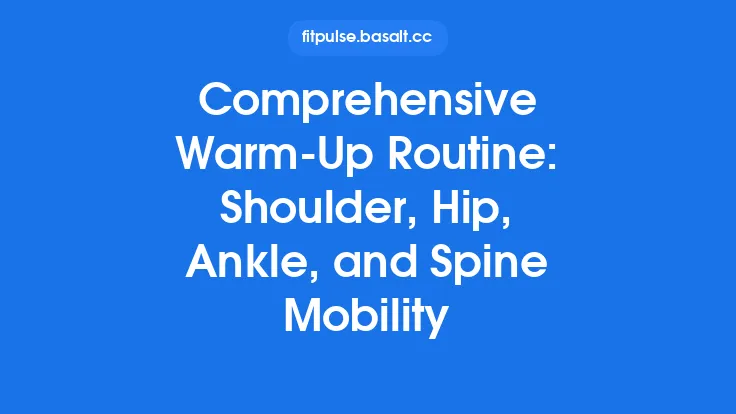Hip mobility and strength are the twin pillars that support virtually every athletic movement—from sprinting and jumping to squatting and rotating. When the hip joint moves freely through its full range of motion while the surrounding musculature can generate and absorb forces efficiently, the risk of compensatory patterns and downstream injuries drops dramatically. Conversely, restricted hip motion or weak hip stabilizers force other joints—especially the knee, lumbar spine, and ankle—to pick up the slack, creating a cascade of stress that can culminate in overuse injuries, acute strains, or chronic pain. This article delves deep into the anatomy, common dysfunctions, and evidence‑based mobility‑strength sequences that athletes, coaches, and clinicians can embed into daily routines to safeguard the hips and enhance performance for the long term.
Understanding Hip Anatomy and Biomechanics
A solid grasp of hip structure is essential for designing targeted prehab protocols.
| Structure | Primary Function | Key Muscles / Ligaments |
|---|---|---|
| Acetabulum | Socket that houses the femoral head; provides stability while allowing multi‑planar motion. | Labrum (fibrocartilaginous rim) |
| Femoral Head | Ball that articulates with the acetabulum; transmits forces from the lower limb to the pelvis. | — |
| Capsular Ligaments | Limit extreme ranges and maintain joint congruency. | Iliofemoral, pubofemoral, ischiofemoral ligaments |
| Muscular Envelope | Generates movement, stabilizes the joint, and dissipates forces. | Flexors: Iliopsoas, rectus femoris; Extensors: Gluteus maximus, hamstrings; Abductors/Adductors: Gluteus medius/minimus, tensor fasciae latae (TFL), adductor group; Rotators: Piriformis, gemelli, obturator internus/external, quadratus femoris |
| Neurovascular Bundle | Supplies sensation and motor control. | Femoral nerve, sciatic nerve, superior/inferior gluteal nerves |
Biomechanically, the hip operates as a ball‑and‑socket joint capable of flexion/extension, abduction/adduction, and internal/external rotation. In functional activities, these motions rarely occur in isolation; instead, they blend into complex, three‑dimensional patterns. For example, a deep squat demands simultaneous hip flexion, external rotation, and abduction to maintain knee alignment and lumbar neutrality. Understanding these coupled motions informs the selection of mobility drills that respect the joint’s natural kinematics and strength exercises that reinforce the appropriate motor patterns.
Common Hip Dysfunction Patterns and Their Impact on Performance
| Dysfunction | Typical Presentation | Performance Consequence | Injury Risk |
|---|---|---|---|
| Limited Hip Flexion (often < 110°) | Difficulty achieving deep squat depth; anterior pelvic tilt. | Reduced power generation in Olympic lifts; compromised stride length. | Hip flexor strains, lumbar hyperextension injuries. |
| Excessive Internal Rotation / Weak External Rotators | “Toe‑out” gait, knee valgus during single‑leg tasks. | Inefficient force transfer in cutting and pivoting. | ACL strain, iliotibial band syndrome, gluteal tendinopathy. |
| Hip Adductor Dominance / Weak Abductors | Hip drop on the stance side during gait; lateral hip pain. | Poor lateral stability, diminished sprint acceleration. | Groin strains, greater trochanteric pain syndrome. |
| Gluteal Activation Deficits | “Dead‑lift” feeling originates from lower back rather than hips. | Suboptimal hip extension power; compromised jumping height. | Lumbar disc pathology, hamstring overload. |
| Capsular Tightness (e.g., Ischiofemoral Impingement) | Pain in deep flexion/extension, especially when seated. | Restricted range in sport‑specific positions (e.g., rowing, cycling). | Labral tears, femoroacetabular impingement progression. |
Identifying these patterns early—through movement screens, range‑of‑motion assessments, and strength testing—allows practitioners to prescribe corrective sequences before compensations become entrenched.
Principles of Effective Hip Prehab Programming
- Specificity – Target the exact motion or muscle group that is deficient. A mobility drill that isolates hip external rotation is more effective for correcting internal rotation bias than a generic “leg swing.”
- Progressive Overload – Just as with strength training, hip mobility improves when the tissue is gradually exposed to greater stretch or load. This can be achieved by increasing range, adding external resistance, or extending time under tension.
- Motor Control Integration – Mobility and strength should be practiced in the context of functional movement patterns (e.g., squat, lunge, single‑leg stance) to reinforce neural pathways.
- Frequency & Volume – Hip tissues respond well to daily low‑to‑moderate volume mobility work (5–10 min) combined with 2–3 strength sessions per week focusing on hip stabilizers.
- Individualization – Baseline assessments dictate which sequences are prioritized. Athletes with a history of hip flexor strains will benefit from a different emphasis than those with chronic adductor pain.
Mobility Sequences: Targeted Drills for Optimal Range of Motion
1. Soft‑Tissue Preparation (2–3 min)
| Drill | Execution Cue | Target Tissue |
|---|---|---|
| Foam‑Roll Iliopsoas | Lie prone, place foam roller under the lower abdomen, gently rock to massage the deep hip flexor. | Iliopsoas, rectus femoris |
| Gluteal Myofascial Release | Sit on a lacrosse ball, cross the ankle over the opposite knee, and roll the gluteus maximus and medius. | Gluteal muscles, piriformis |
| Adductor/Abductor Ball Roll | Lie on side, place ball under inner thigh (adductor) or outer thigh (abductor), roll slowly. | Adductor/abductor groups |
2. Controlled Articular Rotations (CARs) – The Gold Standard (3–4 min)
CARs involve moving a joint through its full, pain‑free range while maintaining a neutral spine and engaging the surrounding musculature.
| CAR | Starting Position | Movement |
|---|---|---|
| Hip Flexion/Extension CAR | Supine, knees bent, feet flat. | Actively flex the hip by pulling the knee toward the chest, then extend by pushing the heel into the floor, keeping the pelvis stable. |
| Hip Internal/External Rotation CAR | Supine, hips and knees flexed 90°, feet flat. | Keeping the thigh stable, rotate the lower leg inward (internal) and outward (external) as far as possible without pelvic tilt. |
| Hip Abduction/Adduction CAR | Supine, hips flexed 90°, knees together. | Open the knees outward (abduction) then bring them together (adduction) while maintaining hip stability. |
Progression: Increase the number of repetitions (3–5 sets of 8–10 slow reps) and add a light ankle weight (0.5–1 kg) once the movement feels effortless.
3. Dynamic Stretching with Neuromuscular Emphasis (4–5 min)
| Drill | Sets × Reps | Key Cue |
|---|---|---|
| Walking Lunge with Hip Flexor Stretch | 2 × 10 steps each leg | Keep torso upright, drive the hip forward, and gently press the rear knee toward the ground. |
| World’s Greatest Stretch (Modified for Hip Rotation) | 2 × 6 each side | From a lunge, rotate the torso toward the front leg, reaching the arm overhead, then return to start. |
| Standing Hip CAR with Band Resistance | 2 × 8 each direction | Anchor a light resistance band to a stable point, loop around the ankle, and perform controlled hip rotations against the band’s tension. |
These dynamic stretches not only improve tissue extensibility but also reinforce the motor patterns required for sport‑specific actions.
Strength Sequences: Building Resilient Hip Musculature
1. Activation Phase – “Prime the Engine” (5 min)
| Exercise | Sets × Reps | Load | Cue |
|---|---|---|---|
| Glute Bridge with Mini‑Band | 3 × 12 | Bodyweight + band (≈ 10 lb) | Squeeze glutes at top, keep knees aligned with toes. |
| Clamshells | 3 × 15 each side | Mini‑band (≈ 5 lb) | Maintain pelvis neutral, lift the top knee without rotating the torso. |
| Quadruped Hip Extension (Donkey Kicks) | 3 × 12 each side | Bodyweight | Keep core engaged, avoid lumbar arching. |
These low‑load, high‑repetition movements awaken the gluteal and deep hip stabilizers, preparing them for heavier loading.
2. Isolation Phase – Targeted Hypertrophy & Endurance (10–12 min)
| Exercise | Sets × Reps | Load | Tempo |
|---|---|---|---|
| Cable Hip Abduction | 4 × 12 each side | 15–20 lb | 2‑0‑2 (eccentric‑pause‑concentric) |
| Standing Hip External Rotation (Band) | 3 × 15 each side | Light band (≈ 5 lb) | 3‑1‑2 |
| Single‑Leg Romanian Deadlift (RDL) | 3 × 8 each side | 30–40 lb dumbbell | 3‑0‑1 |
Focus on maintaining a neutral spine and controlled joint motion throughout each rep. The external rotation and abduction work directly counteract internal rotation dominance, while the single‑leg RDL builds hip extensors and posterior chain coordination.
3. Compound Phase – Functional Load Transfer (15–20 min)
| Exercise | Sets × Reps | Load | Progression |
|---|---|---|---|
| Barbell Back Squat | 4 × 6 | 70–80 % of 1RM | Increase depth gradually, ensuring hip crease passes the knee line. |
| Trap Bar Deadlift | 4 × 5 | 70–85 % of 1RM | Emphasize hip hinge, keep bar close to shins. |
| Bulgarian Split Squat | 3 × 8 each side | Dumbbells 30–40 lb each | Add a pause at the bottom to increase time under tension. |
| Lateral Step‑Up with Knee Drive | 3 × 10 each side | Bodyweight → add 10 lb plate | Focus on hip abduction during the step‑up phase. |
These multi‑joint movements translate the isolated hip strength gains into sport‑relevant power and stability. They also reinforce proper hip‑knee‑ankle alignment under load, a critical factor in injury prevention.
4. Conditioning & Endurance (Optional Finisher)
| Exercise | Duration | Load | Goal |
|---|---|---|---|
| Hip‑Focused Farmer’s Carry (hold kettlebells at sides, maintain hip neutral) | 3 × 30 seconds | 2 × 25 lb kettlebells | Develop hip stability under axial load. |
| Band‑Resisted Skater Hops | 3 × 20 seconds | Light band around thighs | Enhance lateral hip strength and reactive control. |
These high‑intensity, low‑volume finisher drills improve the endurance of hip stabilizers, which is essential for prolonged competition or training sessions.
Integrating Mobility and Strength: Sequencing Strategies for Training Sessions
| Training Phase | Recommended Sequence | Rationale |
|---|---|---|
| Warm‑up (Pre‑Performance) | Soft‑tissue → CARs → Dynamic Stretch → Activation | Prepares tissues, reinforces motor patterns, and primes neural drive without inducing fatigue. |
| Strength/Power Block | Activation → Isolation → Compound → Conditioning | Ensures hip stabilizers are engaged before heavy loading, then transitions to functional lifts, finishing with endurance work. |
| Recovery / Post‑Training | Light Mobility (CARs, static stretch) → Myofascial Release | Facilitates tissue remodeling, reduces residual tension, and promotes circulation. |
A practical example for a typical training day:
- 5 min – Foam‑roll iliopsoas & glutes.
- 4 min – Hip Flexion/Extension CARs (3 sets).
- 4 min – Walking lunges with hip flexor stretch (2 × 10).
- 5 min – Glute bridge + clamshell activation (3 × 12).
- 20 min – Back squat, trap bar deadlift, Bulgarian split squat (as per strength phase).
- 5 min – Band‑resisted skater hops (finisher).
- 5 min – Post‑session hip CARs + static stretch (hold 30 s each).
This flow respects the principle of “mobility first, strength second, mobility again,” ensuring the hips are both supple and robust throughout the session.
Monitoring Progress and Adjusting Protocols
| Metric | Assessment Tool | Frequency | Target |
|---|---|---|---|
| Hip Flexion ROM | Goniometer (supine, knee flexed) | Every 4 weeks | ≥ 120° (or individual baseline + 10°) |
| Hip External Rotation Strength | Handheld dynamometer (side‑lying) | Every 6 weeks | ≥ 30 Nm (or 10 % increase) |
| Glute Activation Ratio (EMG or functional test) | Single‑leg squat depth vs. hip drop | Every 8 weeks | < 5 % hip drop |
| Movement Quality | Video analysis of squat/kick | Every 2 weeks | No valgus, neutral pelvis, smooth hip hinge |
When a metric plateaus or regresses, adjust the protocol:
- ROM Stagnation: Increase CAR volume, add a gentle PNF stretch (contract‑relax) after the mobility block.
- Strength Lag: Incorporate heavier isolated hip work (e.g., hip thrusts) or increase load progression by 2.5–5 lb per week.
- Activation Deficit: Add an extra activation set or switch to a more neuromuscularly demanding variation (e.g., resisted glute bridge with a chain).
Sample Weekly Hip Prehab Routine (Evergreen Blueprint)
| Day | Focus | Main Components |
|---|---|---|
| Monday | Mobility + Activation | Soft‑tissue (2 min) → Hip CARs (3 × 8) → Walking lunges (2 × 10) → Glute bridge + clamshells (3 × 12) |
| Tuesday | Strength – Isolation | Cable hip abduction (4 × 12) → Band external rotation (3 × 15) → Single‑leg RDL (3 × 8) |
| Wednesday | Recovery | Light foam‑roll (2 min) → Static hip flexor stretch (2 × 30 s) → Hip CARs (2 × 6) |
| Thursday | Strength – Compound | Back squat (4 × 6) → Bulgarian split squat (3 × 8) → Lateral step‑up (3 × 10) |
| Friday | Mobility + Conditioning | Dynamic hip CARs with band (3 × 8) → World’s Greatest Stretch (2 × 6) → Band‑resisted skater hops (3 × 20 s) |
| Saturday | Optional Sport‑Specific | Sport‑specific drills (e.g., sprint starts, change‑of‑direction) with emphasis on hip hinge and rotation. |
| Sunday | Rest / Light Mobility | Gentle hip CARs (2 × 5) + breathing‑focused foam‑roll (5 min). |
The routine can be scaled up or down based on training load, competition schedule, or individual recovery capacity. The key is consistency: daily mobility work combined with 2–3 strength sessions yields the most robust, injury‑free hip performance.
Frequently Asked Questions
Q1: How much time should I allocate to hip mobility each day?
A: 5–10 minutes of focused work (soft‑tissue + CARs + dynamic stretch) is sufficient for most athletes. Consistency outweighs duration.
Q2: Can I perform hip mobility drills after a heavy leg day?
A: Yes, but keep intensity low. Post‑training mobility should be gentle, emphasizing static stretches and light CARs to aid recovery rather than push range further.
Q3: Are hip mobility drills safe for someone with a labral tear?
A: Generally, yes, provided the movements stay within pain‑free limits. Avoid deep hip flexion beyond 90° and excessive internal rotation that may exacerbate impingement. Consult a medical professional for individualized guidance.
Q4: How do I know if my hip strength is balanced?
A: Perform a “hip strength ratio” test: compare external rotator strength (e.g., side‑lying external rotation) to internal rotator strength (e.g., side‑lying internal rotation). A ratio of ~1:1 to 1:1.2 is typical; significant deviation suggests imbalance.
Q5: Should I use bands, cables, or free weights for hip strengthening?
A: All have merit. Bands are excellent for activation and early‑phase rehab; cables allow precise loading angles; free weights develop functional, multi‑planar strength. Rotate modalities to keep stimuli varied.
Closing Thoughts
The hip is the central hub of human movement, and its health dictates how efficiently forces travel up and down the kinetic chain. By systematically addressing both mobility and strength—through controlled articular rotations, purposeful dynamic stretches, targeted activation, and progressive compound loading—athletes can build a resilient hip complex that resists injury while unlocking higher performance ceilings. The sequences outlined here are evergreen: they rely on fundamental biomechanics, proven neuromuscular principles, and practical progressions that remain relevant regardless of sport, training era, or equipment trends. Implement them consistently, monitor the metrics, and adjust intelligently, and the hips will reward you with stability, power, and longevity on the field, court, or track.





